The 4 TB Western Digital Red (WD40EFRX)
Like many other 3.5" desktop hard drives, the 4 TB Western Digital Red has a label on the top plate and an uncovered PCB on the underside. The label has a lot of important information, like the hard drive model, store capacity as well as its date and place of manufacture. This particular drive was manufactured in Thailand on 11th August, 2013. Interestingly, Western Digital also added a QR code so you can scan it using your smartphone to learn more about the WD Red NAS hard disk drive.
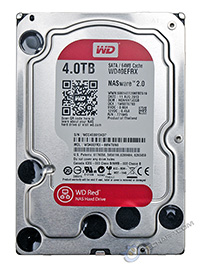 |
 |
 |
While this is an Advanced Format drive, there is no warning on the label about using WD Align with older operating systems like Windows XP. This is because this drive does not support older operating systems like Windows XP. You can use this drive in Windows XP or even Windows 98, but you will be limited to the first 2.1 TB.
Connectors & Jumpers
 |
 |
This is a Serial ATA hard drive, with native support for SATA 6 Gb/s. However, it is backward-compatible so you will have no problem using it with older SATA 3 Gb/s controllers.
The SATA 6 Gb/s interface is necessary for optimal performance since this WD Red hard disk drive boasts a maximum sustained internal (platter-to-buffer) transfer rate of 150 MB/s and a large and fast DDR2 SDRAM cache.
Like all Serial ATA drives, it comes the standard SATA data (left) and power (right) connectors and is hot-pluggable. That means you can connect and disconnect this hard disk drive to your PC while it's still running. To the left of the SATA connectors is the jumper block.
From what we can tell, Western Digital ships some drives with a jumper and others without a jumper. Since our OEM unit did not come with one, it is likely that only retail drives come with the jumper.
According to Western Digital, jumpering pins 1 and 2 enables Spread Spectrum Clocking (SSC). Placing the jumper across pins 5 and 6 will force the drive to use the slower SATA 3Gbits/s transfer speed. This is only necessary for certain SATA controllers that do not properly implement the SATA 6 Gb/s speed negotiation.
Breather Holes
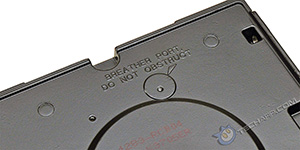 |
The 4 TB Western Digital Red (WD40EFRX) hard disk drive does not have any clearly-marked breather holes on the top plate. The underside has a breather hole (see picture on the right) near the top of the drive. This hole must not be covered.
Breather holes allow condensation inside the hard drive to escape. They also equalize the hard drive's internal pressure with the ambient air pressure. The hard disk drive needs them to function properly, so please make sure you do not occlude the holes!
Peeking Under The PCB
Western Digital has a penchant for keeping all surface-mounted components on the reverse side of the PCB, to prevent static damage and to allow for better cooling. With the PCB out of the way, you can see the two gray thermal pads which help to transfer heat from the controllers to the hard disk drive chassis.
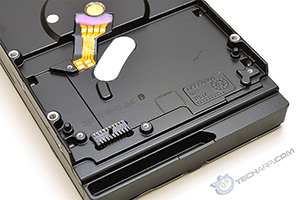 |
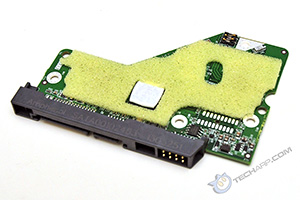 |
The 4 TB Western Digital Red drive uses the Marvell 88i9446-NDB2 drive controller, which is a newer version of the controller used in the 3 TB Red (WD30EFRX), the 1 TB VelociRaptor (WD1000DHTZ) and the 4 TB Re (WD4000FYYZ) drives. This is a dual-core processor, which would boost its ability to handle multiple transactions simultaneously. It also uses an customised ST Microelectronics motor drive controller (WDHC8TD), which features the proprietary Smooth Drive pseudo-sinusoidal digital drive technology. Smooth Drive allows the hard disk drive to minimize torque ripple to reach a higher track density as well as reduce noise levels.
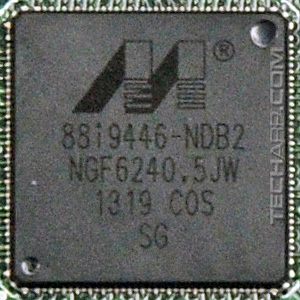 |
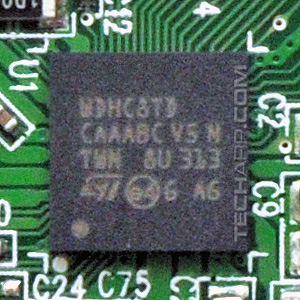 |
 |
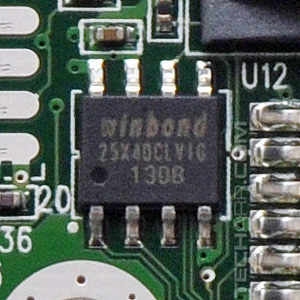 |
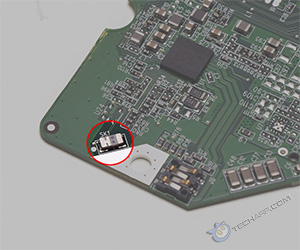 |
The 4 TB Western Digital Red uses the Hynix H5PS5162GFR-S6C, which is the same memory chip used in the 3 TB Western Digital Red (WD30EFRX). This is a 64 MB DDR2 SDRAM chip, with 4 memory banks and an operating speed of 800 MHz DDR. However, its slower timings of 6-6-6 makes it slightly slower than the Winbond W9751G6JB-25 chip used in the 4 TB Western Digital Re (WD4000FYYZ).
![]() To store the NASware 2.0 firmware, Western Digital used a Winbond 25X40CLVIG, which is a serial flash memory chip with a storage capacity of 4 Mbits (512 KB) and a maximum transfer rate of 208 Mbits/s (26 MB/s). Unlike the 4 TB Western Digital Re though, the 4 TB Western Digital Red hard disk drive only features a single shock sensor (highlighted above).
To store the NASware 2.0 firmware, Western Digital used a Winbond 25X40CLVIG, which is a serial flash memory chip with a storage capacity of 4 Mbits (512 KB) and a maximum transfer rate of 208 Mbits/s (26 MB/s). Unlike the 4 TB Western Digital Re though, the 4 TB Western Digital Red hard disk drive only features a single shock sensor (highlighted above).
| If you like this article, please share it! -> |
Support Tech ARP!
If you like our work, you can help support out work by visiting our sponsors, participate in the Tech ARP Forums, or even donate to our fund. Any help you can render is greatly appreciated!
Page |
Topic |
|
1 |
||
2 |
||
3 |
||
4 |
||
5 |
• Testing The 4 TB Western Digital Red |
|
6 |
• Transfer Rate Range, Platter Profile |
|
7 |
||
8 |
||
9 |
||
10 |
<<< Introduction, Specifications, Packaging : Previous Page | Next Page : WD Red Hardware Enhancements, NASware 2.0, TLER Support >>>
Support us by buying from Amazon.com! |
|
| Grab a FREE 30-day trial of Amazon Prime for free shipping, instant access to 40,000 movies and TV episodes and the Kindle Owners' Lending Library! | |







 Add to Reddit
Add to Reddit
